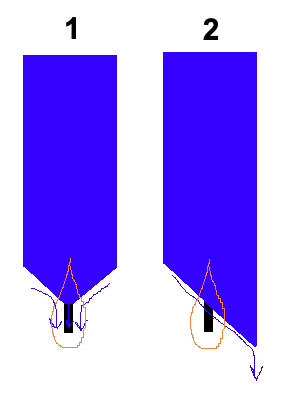How would an upside-down candle burn?
As every child knows, sometimes it’s fun to do something exactly wrong. In that spirit, what would happen if you burned a candle upside-down?
To take a guess, we need to understand how candles work. Their simplicity is deceptive; burning candles are actually pretty complex systems with many interacting parts and processes. They illustrate a slew of different chemical and physical effects so elegantly that the famous physicist Michael Faraday gave a series of lectures on candles using them to demonstrate effects from from turbulence to buoyancy to blackbody radiation and to explain the chemistry of fire. Candle flames are such common sights that we often overlook their complicated anatomy; look at one closely and you’re likely to see a number of features, from the blue glow at the bottom to the tapering of the tip, that everybody recognizes but few people could actually explain if asked.
Explaining all of candle physics would take a textbook, but for this question, we only need to think about things that change when the candle is turned upside down, which simplifies the problem a lot. The most obvious is that the heat of the flame, normally drawn up and away because hot air’s less dense than cold air, will flow directly into the tip of the candle. Under normal operation, the tip of the candle wax is just hot enough to melt a small pool of wax but not hot enough to boil it, putting it at between 50°C and 370°C. By contrast, the spot one wick-length above the tip of the wick is in the core of the flame, with a temperature in the vicinity of 1000°C. If you could somehow turn just the flame upside-down without turning the rest of the candle, the flame would melt the wax a lot.
However, candles are cyclic systems with a lot of feedback - the flame melts the wax which feeds the flame and so on. We’ve guessed how the change in the flame caused by flipping the candle might affect the wax, but how would that change in the wax then affect the flame in turn?
The flame’s shape would obviously change since the hot gas would be deflected as it rises by the block of wax in its way. How would the burning itself change, though? An important fact is that in candles, the wax only combusts as a vapor. It starts as a solid, is melted and drawn up into the wick and into the heart of the flame by capillary action, and is vaporized by the high heat. It’s only then that combusion happens - the hot, vaporized wax molecules react with oxygen and give off heat, perpetuating the process. In the upside-down candle, more wax would be in the region of high heat, so there would be more hot surface area for vapor to escape from. This means that wax would vaporize and burn at a higher rate, which, all else being equal, should give a bigger flame.
However, there’s a problem with this situation. This augmented flame would melt a lot of wax; what if it melts wax faster than it can vaporize it? In a normal candle, there’s a small cup in the solid wax that holds the melted wax, but in the upside-down candle, the cup’s turned over. All the excess wax might run and fall off the candle unburnt, so the candle would both go through wax faster and drip a lot. There’s a stranger possibility, though. What if the flame melts wax that floods down over the wick too thickly for the flame to vaporize it in time and snuffs it out? Like Icarus, it’d die from melting wax and its own zeal. This was my guess for what would happen to the upside-down candle.
I also asked friends to guess how an upside-down candle would burn and got around 10 responses. Most people either gave the self-snuffing scenario - let’s call it scenario (1) - or the second, self-sustaining scenario - say, (2).

To answer this question, I dangled a candle, set up another for comparison, and lit them. A video of the result is here. Forgive the subpar quality.
This matched scenario (1) - the candle initially burns, but once it starts to melt wax it’s quickly put out. Out of curiosity, though, I ran another trial with the same candle. The result was wholly different, matching scenario (2). It turns out that the same candle can follow either path, probably depending on the initial shape of the tip and wick. The phase-space of this upside-down candle has two basins of attraction.
Here’s a video of the second trial. Most people were right at least once. Nobody, however, predicted the stalactite.